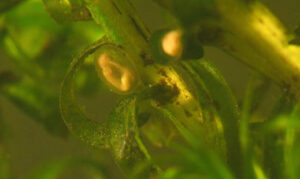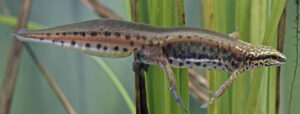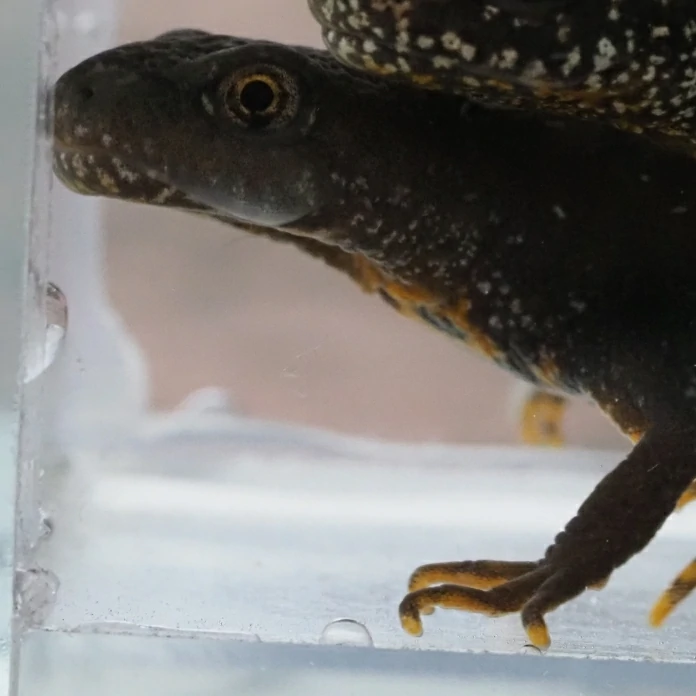Have you ever seen a newt sliding through a pond or hiding under damp leaves and wondered how it comes into the world? You might ask: are newts oviparous?
Yes, newts are oviparous. They lay eggs that grow outside their bodies, usually in water or on damp plants. Female newts carefully attach each egg to a leaf or stem to keep it safe until it hatches.
How Newts Lay Their Eggs in the Wild
Newts are interesting creatures, not just because of their smooth skin or tiny tails, but because of how they reproduce.
Female newts lay eggs in water or on damp plants, depending on the species.
They don’t just drop them anywhere, they pick safe spots, often folding leaves around eggs or sticking them to underwater plants.

You might wonder, “Why go through all that trouble?” Eggs left floating freely can be eaten easily by fish, insects, or other predators.
By attaching them to plants, newts give their babies a better chance to survive. In some species, females can lay hundreds of eggs in a season, placing each one carefully.
For example, the smooth newt in Europe folds a leaf around each egg. It’s almost like the female is giving her young a tiny blanket.
Seeing this in the wild is rare, but if you have a calm, clear pond, you might spot the folded leaves underwater.
What Oviparous Really Means
Oviparous might sound complicated, but it’s really simple. Being oviparous means an animal lays eggs, and the young grow outside the mother’s body.
Birds, frogs, and many reptiles are oviparous too.
For newts, being oviparous has some important effects:
-
Eggs must stay moist to survive. That’s why newts usually choose ponds, slow streams, or damp leaf litter.
-
Temperature and environment play a big role. Eggs in warmer water grow faster, but if it gets too hot, the embryos can die.
-
Unlike mammals, newts don’t take care of their eggs after laying them, so picking a safe spot is very important.
How Long Does It Take for Newt Eggs to Hatch?
Once the eggs are laid, the waiting starts. Depending on the species and water temperature, newt eggs usually hatch in two to six weeks. In cooler ponds, it takes longer.
The baby newts, called larvae, look more like tiny fish than adult newts at first. They have gills to breathe underwater and a tail to help them swim.

Some larvae stay in water for several months, growing and losing their gills as they get ready to move onto land.
This stage is delicate, and many predators see them as a tasty snack. That’s why folding the leaf around eggs is so smart, it gives the larvae a small head start.
Do Male Newts Help With Eggs?
You might wonder, “Do male newts do anything to help?” In most cases, male newts don’t guard the eggs, but they play an important role before the eggs are laid.

Male newts perform courtship dances in water to attract females. These dances involve swaying tails, moving in circles, and releasing scents that show they’re ready to mate.
Once the female lays her eggs, the male’s job is mostly done. This is different from some other animals, like certain fish or birds, where males might guard the nest.
Where Do Newts Lay Eggs?
Different newt species have slightly different preferences. Some lay eggs fully underwater, while others attach them to leaves or moss just above water.
Here’s a quick look at a few examples:
-
Smooth newts: Lay eggs underwater, often folding leaves around them.
-
Great crested newts: Prefer deeper ponds with lots of plants.
-
Eastern newts: Can lay eggs on submerged plants, sometimes in tiny clusters.
Even though the locations vary, the principle is the same: eggs need moisture and protection.
Why Being Oviparous Matters for Newts’ Survival
Being oviparous comes with both benefits and risks. On the plus side:
-
Females can lay many eggs at once, increasing chances that some will survive.
-
Eggs are hidden in plants, which can protect them from predators.
But there are challenges:
-
Eggs are exposed to environmental changes like temperature shifts or drying ponds.
-
Predators can still find them, especially if eggs are left in open water.
Despite these risks, newts have thrived for millions of years. Their careful egg-laying strategy is one reason they continue to survive in ponds, streams, and wetlands around the world.
How Newt Eggs Develop Into Young Newts
After hatching, the larvae start life underwater. They have tiny gills on the sides of their heads and tails shaped for swimming.
At this stage, they are completely dependent on the water and on eating tiny insects, larvae, or plankton.
As they grow, they go through a process called metamorphosis. This is when they gradually:
-
Lose their gills
-
Develop lungs for breathing air
-
Grow limbs strong enough for crawling on land
Laying eggs in water gives larvae a safe start in a place where they can feed and grow before moving onto land.
Are All Newts Oviparous, or Are There Exceptions?
Almost all newts are oviparous. There are very few exceptions among amphibians, but newts stick with the egg-laying strategy.
Some salamanders and other amphibians give live birth, but newts haven’t changed that way.
This makes them a great example of oviparous reproduction: the female puts effort into finding the right spot and placing each egg carefully, but doesn’t carry the young inside her body.
How Humans Can Observe Newt Eggs Safely
If you want to see newt eggs in the wild, you need to be careful. Touching them can damage the delicate jelly around the egg or leave oils from your skin that harm the embryo.
Here are some tips:
-
Look for eggs in calm ponds with plenty of plants.
-
Watch for folded leaves underwater, these often hide eggs.
-
Observe from a distance, and don’t remove eggs from their natural home.
By respecting their environment, you can see how oviparous animals like newts carefully continue their life cycle without interfering.
Fun Facts About Newt Reproduction
Here are some little-known facts that make newts even more interesting:
-
Female newts can lay hundreds of eggs in a season, but they place them one by one.
-
Some species lay eggs in water in early spring, while others wait until late spring or summer.
-
Larvae can detect vibrations in water, helping them avoid predators even before they leave the egg.
-
Male courtship dances are so precise that females often choose mates based on how well they perform underwater displays.
Conclusion
So yes, newts are oviparous. They lay eggs that grow outside the mother’s body, usually in water or on damp plants. This egg-laying strategy shapes how newts live, grow, and survive.
From careful placement of eggs to the delicate larval stage, everything about newts’ early life depends on this simple but smart method.
Next time you spot a tiny newt sliding under a leaf or swimming quietly in a pond, remember: each of those eggs is a careful investment in the next generation.
Being oviparous is more than just a word, it’s a survival strategy that has kept newts thriving for millions of years.
Hi, my name is Ezra Mushala, i have been interested animals all my life. I am the main author and editor here at snakeinformer.com.

